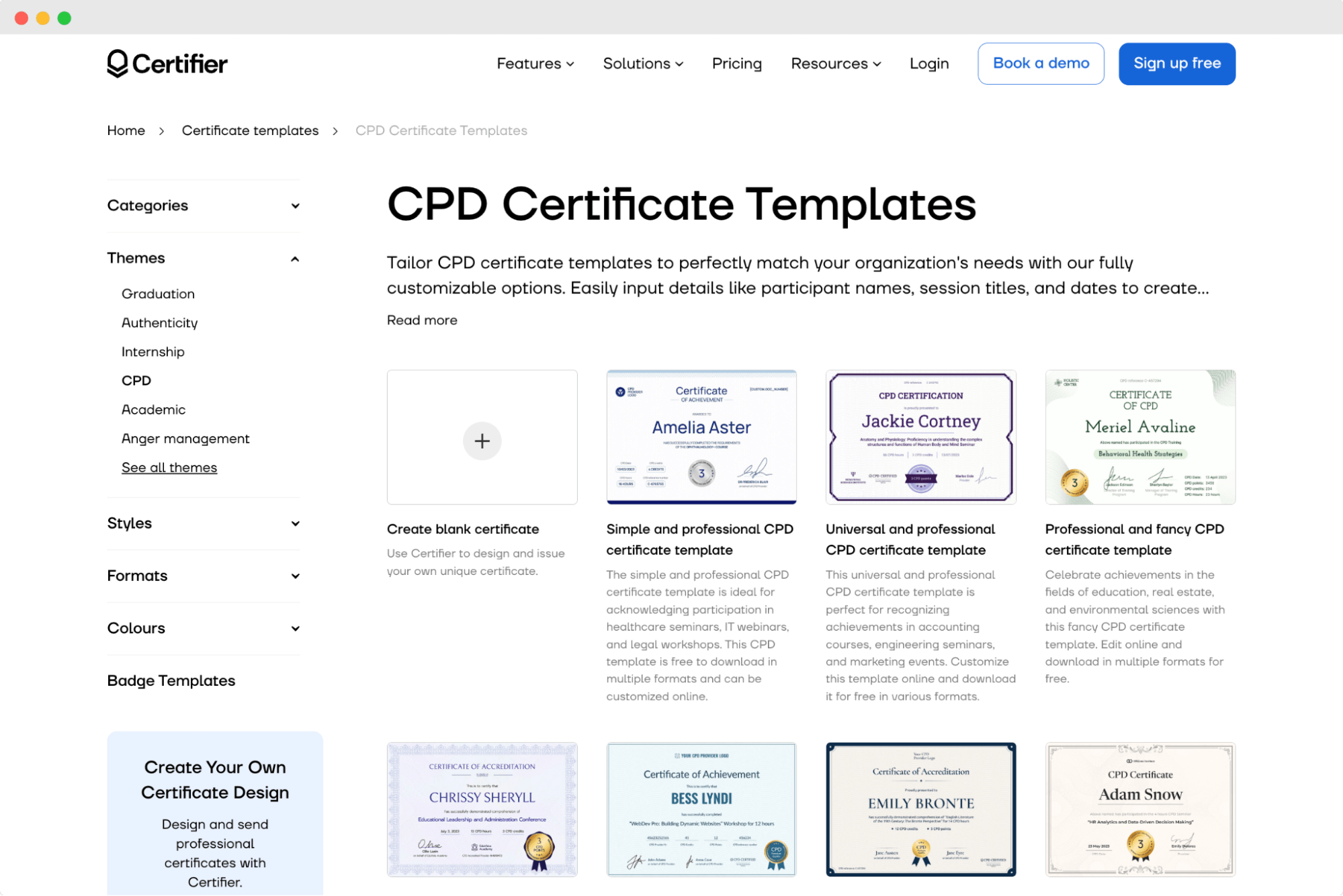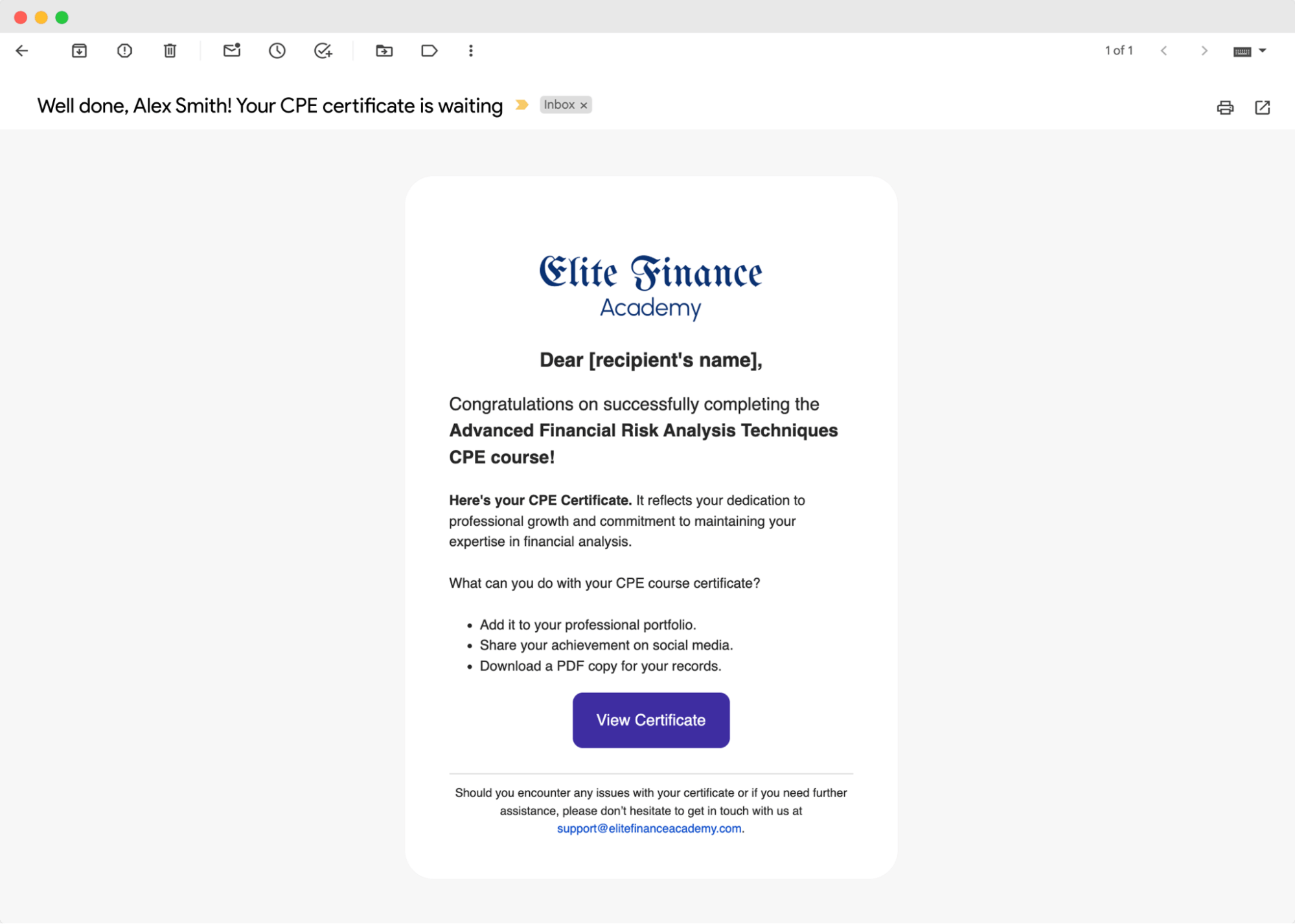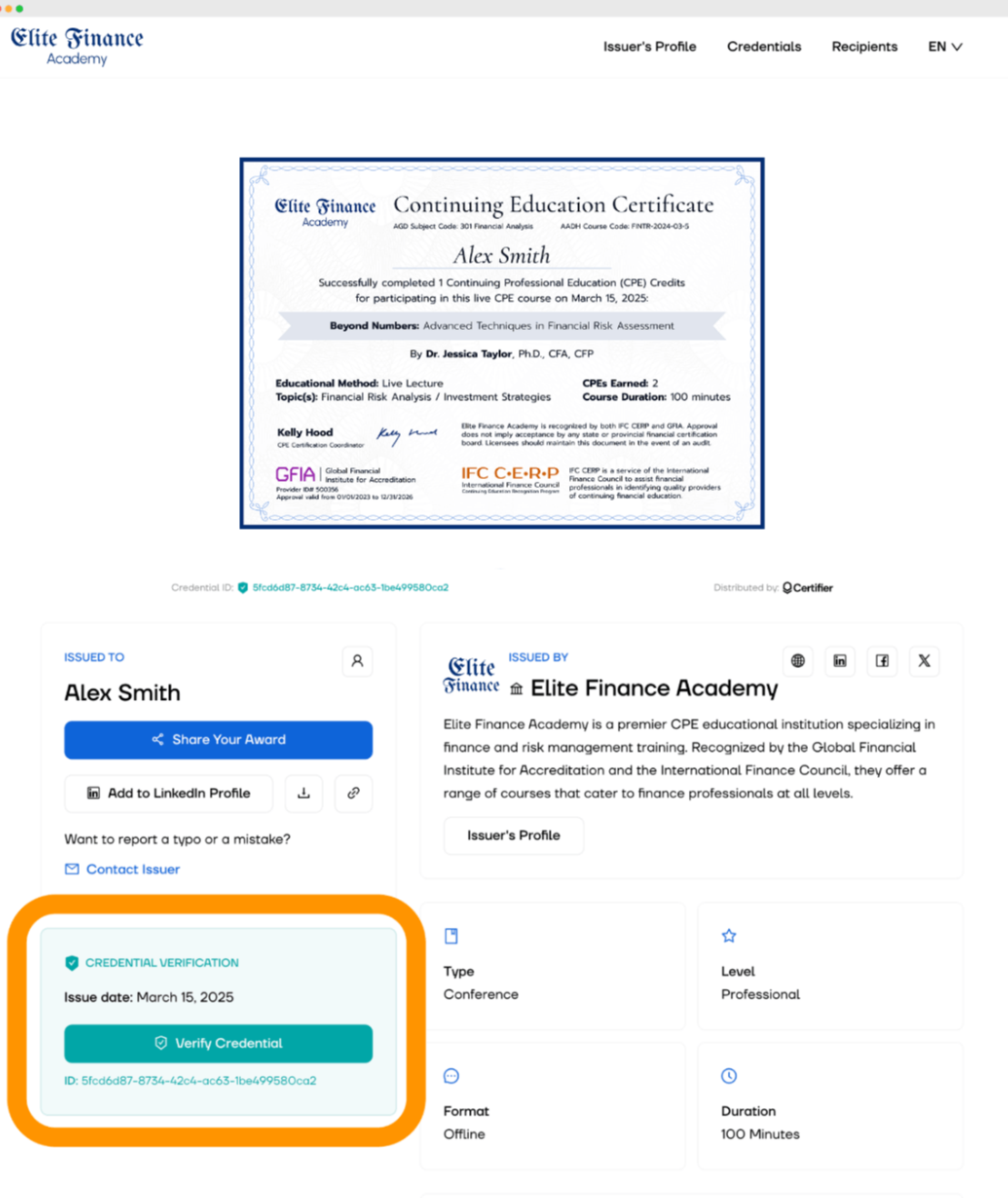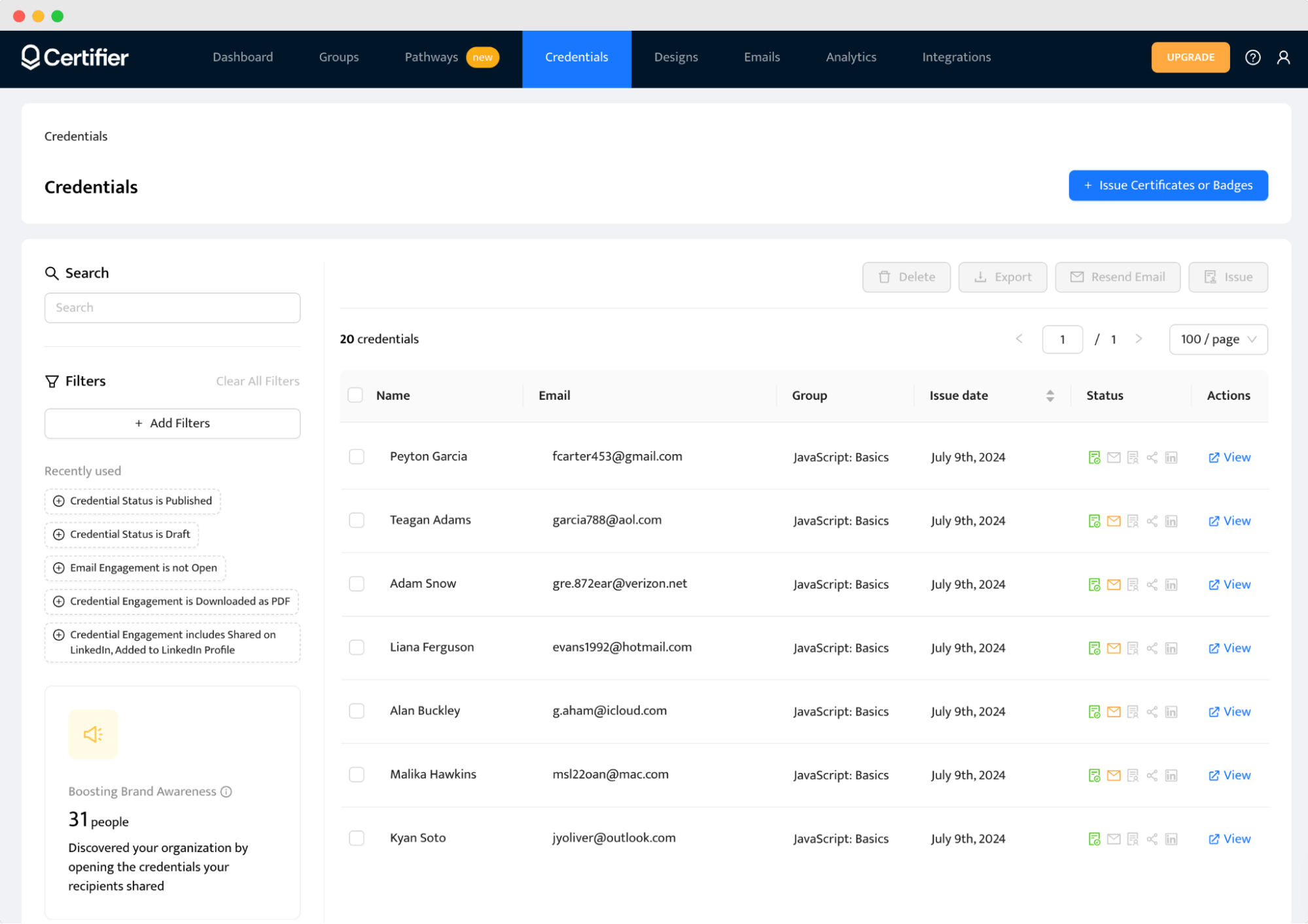Trusted by:
Updated: June 24, 2025
13 min read
How to Become a CPE Provider: A Step-by-Step Guide for Course Organizers
Launch a seamless CPE provider experience. We provide a detailed roadmap to receive CPE accreditation and expert insights for delivering exceptional Continuing Professional Education. Become the leading choice for learners seeking valuable CPE credits.
CPE accreditation is a powerful mark of authenticity that signals trust, rigor and reliability to stakeholders. It can be your golden ticket to an engaged audience who puts emphasis on continuing professional education (CPE).
How to prepare your educational program for successful approval? Where to look for reliable information about what to cover in the initial application?
That’s where a trusted guide becomes indispensable. Certifier is a CPD Standards Office partner that specializes in guiding training providers through the maze of high accreditation standards, especially within the CPD (and, by extension, CPE) certification ecosystem.
What are CPE qualifications?
CPE qualifications refer to the structured, industry-recognized credentials that validate a professional’s ongoing education. In fields that change rapidly (such as accounting, finance, cybersecurity and healthcare), they are required to prove professional competence.
What is the difference between CPE & CPD?
CPE (Continuing Professional Education) is especially common in the United States. It often applies to professions that have stringent regulatory or licensing requirements.
CPD (Continuing Professional Development) is more prevalent in the United Kingdom, Australia and Canada . While similar to CPE in that it tracks professional learning, CPD courses tend to take a broader approach. The focus might go beyond regulatory compliance to career advancement, personal development and skill-building.
Despite these differences, both CPE and CPD providers revolve around the same principle: ensuring professionals ongoing commitment to develop industry competencies.
What are CPE credits?
What is CPE credit? When a course is recognized by a governing body, each hour of learning typically converts into CPE points (also known as CPE credits).
What CPE points mean? These points prove that the learner has invested a specific amount of time in continuing education.
Here’s a visual sample of how continuing education credits can look on the CPE certificate. Notice also the clear indication of the course title, training program details and course duration:

A standard guideline in the U.S. is that 1 CPE point equals 50 minutes of formal learning. This time can be spent watching course videos, reading materials, participating in webinars or completing assessments.
Please note: Depending on the field or regulatory body, the number of points required can vary—financial professionals might need 40 credits per year, while IT security specialists could aim for 30.
Why should you consider CPE accreditation?
Quality CPE programs have real advantages for course providers, learners and employers.
Course creators: Offering accredited CPE courses can open doors to an audience actively seeking official CPE credits or CPD points. Since these learners must complete a specific number of hours or credits each year, they are more likely to choose a course that helps them meet those CPE requirements. Accredited courses often command higher market value as stakeholders acknowledge recognized curriculum reliability.
Learners: CPE course accreditation is quality assurance for them. They’re confident that the training course meets established professional CPE standards. When they earn certificates from accredited educational courses, it holds more weight on their resumes or professional portfolios, making it easier to climb the career ladder or switch roles in the future.
Employers: Many industries have strict compliance mandates. By choosing accredited courses from the CPE national registry, companies ensure their staff is learning up-to-date, high-quality course content that improves performance and maintains compliance.
How to become a CPE provider?
The process of how to get CPE accreditation varies slightly from one country or region to another, but the overall steps share a common structure:
Step 01: Identify the target industry & niche
Step 02: Find the relevant accrediting authority
Step 03: Prepare course materials that meet standards
Step 04: Submit the application process
Step 05: Application review process & approval
Step 01: Identify the target industry & niche
Before you start your journey as a continuing education programs provider, clarify the subject area of your courses.
Getting clear on your niche up front helps you pick the right accrediting body. Each field has distinct standards for curriculum length, instructor qualifications and assessment methods.
Go in-depth: Get to know CPE course types. Here’s how to identify the right CPE type for your organization.
Step 02: Find the relevant accrediting authority
Once you identify the learners you want to offer CPE credits for, look for the institution granting CPE accreditation in your region or industry.
How to offer CPE credits?
United States
NASBA (National Association of State Boards of Accountancy): National Registry of CPE Sponsors and State Boards, particularly relevant for accounting, auditing and finance programs.
AICPA (American Institute of Certified Public Accountants): A leading body for CPA-related accreditation.
United Kingdom
CPD Certification Service (CPDUK): Central for CPD accreditation, which overlaps heavily with CPE standards.
Australia
ASQA (Australian Skills Quality Authority): Oversees vocational and educational training accreditation.
Canada
Provincial regulatory bodies: Similar to the U.S. system, but often managed at the provincial level.
National associations like CPA Canada for accounting-related content.
Other regions
Some countries have unified national councils; others rely on multiple professional bodies. A quick online search or inquiry within local industry groups will lead you to the correct authority.
Step 03: Prepare program materials to provide evidence
You need to show accrediting bodies exactly what you have to offer. They want to see credible evidence that your content is relevant and truly beneficial for learners.
Accrediting authorities typically ask for:
A clear syllabus or curriculum showing learning objectives and course structure.
Instructor credentials (e.g., certifications, degrees, relevant experience).
Assessment plan to demonstrate that learners gain new knowledge or skills (think quizzes, exams or assignments).
Course duration and how it aligns with credit hours (often 1 credit per 50 minutes of instructional time).
Pro tip: Structure your content in a way that is easy to evaluate. A well-organized content development or module breakdown helps accreditation reviewers see exactly how many hours (or credits) the course covers.
Step 04: Submit the application process
The next move is to formally apply for accreditation. Each organization has its own submission process, but you can generally expect to provide:
Your detailed syllabus, clearly mapping out all learning activities and necessary skills.
Instructor bios that demonstrate technical expertise and authority in the subject.
A description of your delivery method (e.g., online courses, group live, group internet based, individual courses, self-study courses).
Information about the final exam format and any procedures for exam retakes.
Most accrediting bodies expect you to show how your courses promote continuous improvement. Emphasize any updates you plan to make based on learner feedback or regulatory changes.
Be sure: Check the contact listed on your accrediting body’s website to clarify any questions you have before submitting your initial application.
Step 05: Application review process & approval
Once the initial application is in, you will undergo an application review process where the accrediting body examines your program’s depth, structure and adherence to professional standards.
They may request additional info or clarifications. If everything checks out, you’ll be granted status as an approved sponsor or be added to the registry of CPE sponsors.
Tips to successfully complete application for CPE accreditation:
Timely manner: Respond to inquiries from the accrediting authority as quickly as possible. Delays can push back your official approval date.
Final authority: The accrediting body’s decision is typically conclusive. If approved, you can publicly display your registered sponsors badge and issue continuing development certificates to participants.
Most popular programs that get CPE course accredited
The learning activities that qualify for CPE credits generally fall into two categories: technical and non-technical.
Both types contribute to the professional competence of a CPA, though in different ways.
Technical fields directly align with the accounting profession and a CPA’s business context, while non-technical fields address broader business skills that indirectly support a CPA’s role.
Technical fields of study
Accounting (including Governmental)
Auditing (including Governmental)
Business Law
Economics
Finance
Information Technology
Management Services
Regulatory Ethics
Specialized Knowledge
Statistics
Taxes
Non-technical fields of study
Behavioral Ethics
Business Management & Organization
Communications and Marketing
Computer Software & Applications
Personal Development
Personnel/Human Resources
Production
Here you can get a detailed and updated NASBA list of fields that qualify for CPE accreditation.
How can Certifier make this CPE provider journey smooth & pleasant?
At the core of the CPE accreditation is a certification that documents learners’ progress.
Certifier makes it easy to issue, track and renew Continuing Professional Education (CPE) certificates with minimal effort. The platform is designed to be friendly and intuitive, so you can focus on teaching while it handles the paperwork.
What do you need to issue certificates upon successful CPE course completion?
Ready-made certificate templates
Automated delivery
One single management hub
Integrations with the best LMS tools
Personalized communication
Verification options
Recertification
CPE certificates customizable to requirements
Certifier offers an extensive library of ready-made certificate templates designed by professionals for various industries. You’ll find industry-specific designs for fields like IT, cybersecurity, human resources, healthcare, finance.

Just pick a template that suits your course, then easily customize it with your logo, colors and course details. These templates ensure your certificates look polished and relevant to your field, which means better branding and a more professional impression on your recipients.
And because the templates are already formatted to include all the key information (like course name, credits, dates, etc.), you’ll save time and stay compliant with industry standards.
Automation to eliminate manual tasks
One of the biggest advantages for busy CPE providers is putting certificate issuance on autopilot.
Certifier includes automation features that take care of the repetitive work for you. For example, you can generate certificates in bulk using a list of participant details (and skip the hours of manual editing).
The platform will pull each learner’s name (and other details) into your certificate template automatically, so every certificate is personalized without you having to type a single name.
Instead of your team spending weeks preparing and mailing out annual CPE certificates to 2,000 members, you could upload your roster to Certifier and let it do the heavy lifting overnight.
Personalized instant or scheduled delivery
Certifier supports automatic certificate issuance the moment someone completes a course.
Once certificates are generated, the system can instantly email them to each learner—no need to draft individual emails or attach PDFs one by one.
Certifier lets you set up three types of automated emails:
delivery email (with the certificate attached or linked)
reminder email
expiration notification

By automating generation, emailing, and reminders, Certifier frees your team from tedious tasks and reduces the chance of human error. It’s like having a virtual assistant for your certification process, working 24/7 to keep things running smoothly.
Secure certificate verification
Certifier addresses security by providing verifiable digital certificates. Each certificate issued through the platform comes with a unique digital fingerprint (such as a unique URL or QR code) that allows anyone to verify its authenticity with a single click.

For example, an employer or licensing board can click the Verify Credential link on a digital wallet, and they’ll see confirmation that the certificate is valid, who the issuer is and that it hasn’t been tampered with. This one-click verification system gives peace of mind that every certificate is legitimate and traceable back to the source.
Automatic expiration reminders and renewals
Many professional certifications and education credits have expiration dates or renewal requirements—and keeping track of those can be a nightmare if done manually.
Certifier simplifies this by letting you set an expiration date on certificates and automating the renewal reminder process. You can specify how long a certificate is valid (for example, one year for a CPE course that needs annual renewal).
The platform will then automatically send out email reminders as the expiration date approaches, ensuring neither you nor the learner forgets about renewing their credentials.
By default, Certifier can notify recipients a couple of weeks before their certificate expires, and again when it actually expires, all without you having to remember to do it. These reminder emails are, of course, customizable—you can remind learners about next steps to renew (like signing up for a refresher course or taking an exam) and maintain a professional tone consistent with your brand.
Built for usability and time-saving at any scale
Certifier is designed to be easy for your team to use, whether you’re handling 50 learners or 5,000. For small training companies, this means you won’t need a technical expert or a large staff just to manage certificates—the interface is intuitive and user-friendly.
Many users report that they learned how to use Certifier in no time (one user noted they got up to speed in about 30 minutes).
Create and Send Digital Credentials
One single dashboard (integrated with LMS)
Keeping track of thousands of certificates and recipients can be challenging—but Certifier makes it simple by organizing everything in one place.
The platform provides a unified dashboard where you can manage all your certificates, recipient data and templates centrally. Instead of juggling spreadsheets or multiple systems, you can log in to Certifier and see all your issued certificates at a glance.

From this dashboard, you have full control. Need to correct a typo on a certificate or re-send an email to someone who missed theirs? No problem—you can update certificate details or send out credentials with a few clicks.
Certifier plays nicely with the other platforms and tools CPE providers use, which is a huge time-saver for growing training organizations. Certifier offers integrations (via API, Make, Pipedream or Zapier) with popular systems like TalentLMS, Circle, HubSpot, and many others. This means you can connect Certifier to your Learning Management System, community platform or CRM so that data flows automatically and no duplicate data entry is required.
The result? Accredited Continuing Professional Education course with automated certification
You can handle your CPE provider role with the right resources.
By implementing the strategies detailed in this guide, you'll be well on your way to creating a CPE program for other professionals that adheres to high standards and new technologies (and actively contributes to the professional growth of your attendees).
Certifier simplifies this CPE journey and automates the certification process—freeing you up to focus on delivering quality education.
Let's get started on transforming your educational offerings today! Create a free account.
FAQ about Continuing Professional Education (CPE) course accreditation
We've compiled a list of the most common questions to help you understand CPE course meaning from every angle.



